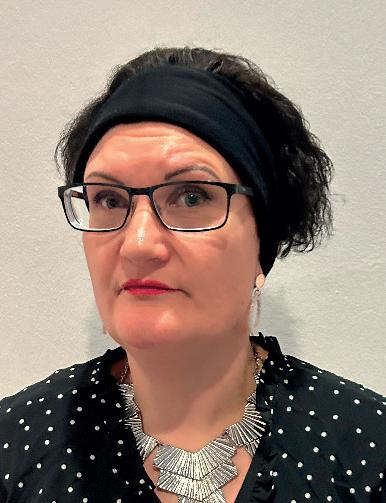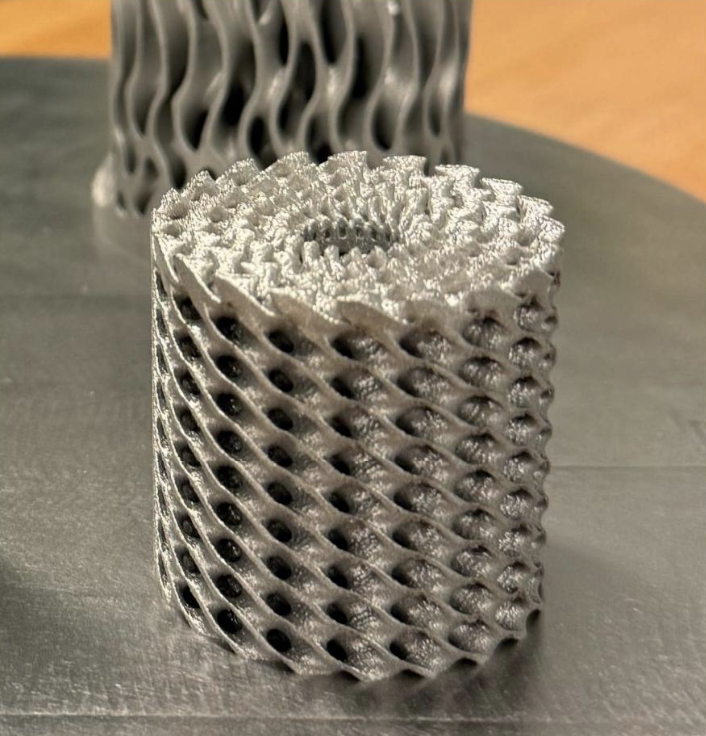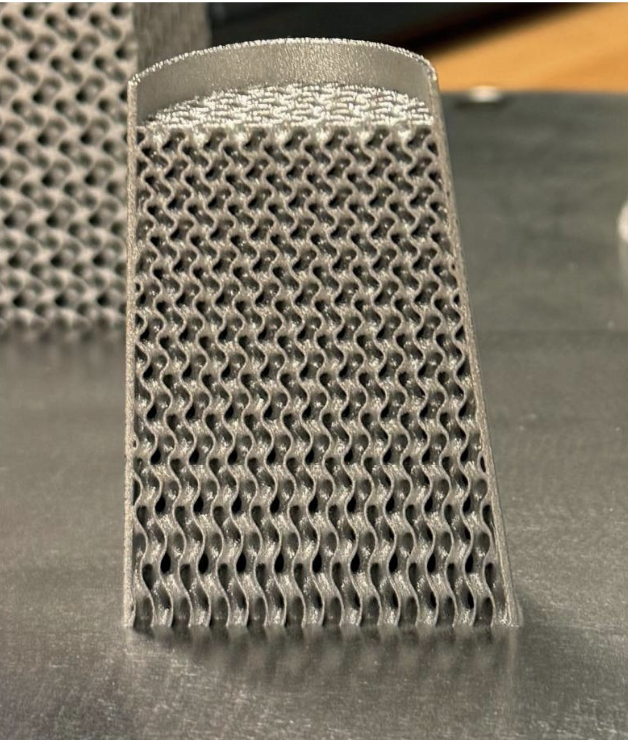
7 minute read
Erik Haapa, Heidi Piili: Doctoral thesis of Heidi Piili: Industrial 3D additive manufacturing – option for Finnish chemical engineering industry by optimized design of products
from Materia 1/2024
Affiliation: Digital Manufacturing and Surface Engineering (DMS), Department of Mechanical and Materials Engineering, University of Turku, Finland
New technologies are shaping our society. Digitalization impacts our daily lives in countless ways, from interpersonal interactions to the search and purchase of products.
The fourth industrial revolution encompasses various modern technologies that can fundamentally alter the manufacture and delivery of products. One of these is additive manufacturing (AM), commonly known as industrial 3D printing.
Additive manufacturing is a modern digital manufacturing technique that enables the layer-by-layer production of, for example, parts with complex internal structures or assemblies as one part directly from a digital 3D model. e widespread adoption of this technology has previously been hindered by patent issues and by limited availability of AM systems and materials, but the AM market has grown rapidly in the last decade.
The COVID-19 pandemic initially impacted AM markets, but the industry has swi ly recovered and grown. Particularly the additive manufacturing of metal products is expected to grow in the coming years.
The growth of AM is influenced by its freedom in design, as well as by its ability to fabricate complex structures and to meet customer needs rapidly. Industries such as automotive, aerospace, and pharmaceuticals utilize additive manufacturing for final product manufacturing. e electronics industry is also witnessing growth, especially with the rise of start-ups. Ability to fabricate parts with multimaterial AM is very promising for this area of industry.
Globally, additive manufacturing has matured, being used several years in industrial mass production. Ongoing technological innovations and research investments support the growth of this industry. In Finland, the number of industrial AM systems is steadily increasing, and AM applications are expanding across various industrial sectors.
The diversity and continuous development of AM bring a broader range of applications. New applications, materials and techniques further expand the possibilities of the field. Nevertheless, additive manufacturing is still in its development phase. Especially this holds when discussing the integration of additive manufacturing seamlessly with traditional manufacturing processes in terms of workflow and compatibility and post-processing steps, such as heat treatment or surface finishing, which are o en required to meet specific performance and quality standards.
The chemical industry has yet to fully leverage the potential of additive manufacturing, both domestically and internationally. Traditional manufacturing methods like molding and machining still dominate the industry, and industrial players may be cautious about adopting the new manufacturing technologies. One obstacle is the prevailing perception of AM as slow, especially for large components or high-volume production. is overlooks the economic savings achieved over the lifespan of product, such as reduced pumping energy for a flow-optimized component. Additionally, it is crucial to realize that not every part needs to be made by AM. Selective printing of critical components, like a nozzle, can be more efficient. e material selection available for AM is expanding rapidly, but so far it is limited as compared to the range of materials used in the chemical industry. e high costs of equipment acquisition and the expertise required for using this technology also hinder the implementation of AM.
The additive manufacturing of metals is a revolutionary technology but has limitations like any other manufacturing technique. ese constraints can significantly impact product design. For instance, support structures are o en necessary for geometries with angles below 45 degrees in relation to the horizontal building platform, adding complexity and time to the manufacturing process. Removing supports can be labor intensive but it is essential for achieving the desired product.
The main contribution of Piili´s thesis is a solution to overcome the current design constraints and challenges in AM of metals. is solution integrates automated design tools for simulation-based optimization and real-time monitoring of the AM process using artificial intelligence algorithms in additive manufacturing of metals. e dissertation proposes that this solution can overcome current design limitations and significantly improve product performance.
According to the solution presented in the doctoral thesis, it is possible to create support-free structures by minimizing heat-induced distortions and ensuring high-quality surfaces, even at zero-degree building angles. e solution operates by introducing the desired component information, such as flows, their directions, operating temperature, physical dimensions, and functionslike separation and purification, into an automatic design tool.


The design program considers the material available for fabrication and its behavior during the AM process using a database with results from manufacturing parameters, material parameters, and experimentally verified simulation results. e database also includes real-time monitoring results of the AM process. By using artificial intelligence algorithms, the program can predict in advance how challenging shapes, such as surfaces below 45-degree building angles can be produced. is information is available for the entire AM-fabricated part, and real-time process monitoring can track the completion of the part. Since the location of challenging geometry is known in advance, the problems can be addressed instantaneously.
Some manufacturers of AM systems have advanced solutions for overcoming these AM challenges. For example, in one solution, a geometric feature recognition system provides information from multiple layers. e system analyzes the current layer being manufactured and the previous layers, defining the manufacturing strategy for the next layer. e challenge is that the manufacturing strategy is calculated in real-time, allowing only a few layers to be fabricated at a time.
In another commercial system, real-time overheating is monitored, and the system adjusts energy input to prevent overheating issues, increasing manufacturing success rate. According to the manufacturer, the ability to identify these issues in real-time is a significant advantage, as it allows for immediate correction and manufacturing of metal parts according to defined design parameters. e challenge of the system is that the manufacturing strategy or overheating issue has not been analyzed and calculated in advance before fabrication, which limits the calculation of the best corrective solution.
The current commercial systems are capable of making limited adjustments to the process and of reducing AM design constraints. In comparison, the system proposed in Piili’s doctoral thesis can enable a higher degree of process adjustment due to precalculated process parameters. Also, thanks to the integration of automated product design and simulation tools, the geometry itself can be optimized and complicated designs can be automated. For example, this could mean the optimization of pore size, geometry and distribution in filtering membranes for improved filtering and pressure loss.
Catalytic reactors can be optimized and tailored for specific reactions. Adsorbents can be tailored for optimized porosity and selectivity. Perhaps one of the most common use cases might be the generation of fluid channels which are simultaneously optimized for flow performance and additive manufacturing. ese benefits extend beyond individual applications, proving valid in scenarios involving number-up or scale-up. e cumulative impacts are an increase in efficiency, a reduction in resource consumption and an improvement in product quality. ese advancements are crucial for meeting the dynamic demands in the chemical engineering industry and for addressing environmental and sustainability challenges.
The doctoral thesis suggests that automated design algorithms can solve the economic challenge of designing complex parts in the near future in AM of metals. e future outlook also emphasizes addressing the qualitative challenges of AM and advanced numerical modeling as part of a comprehensive computational design tool.
AUTHORS: ERIK HAAPA AND HEIDI PIILI
A conceptual, holistic framework to overcome limitations and constraints of design in laser based powder bed fusion of metals: Case novel separation and puri cation units - LUTPub
The dissertation has been published in the Acta Universitatis Lappeenrantaensis research series (at LUT University) number 1112 of the university. ISBN 978-952-412-019-7, ISBN 978-952-412020-3 (PDF), ISSN 1456-4491 (Print), ISSN 2814-5518 (Online).









